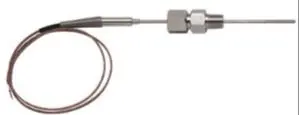RTD
A Resistance Temperature Detector (RTD) is a type of temperature sensor that measures temperature by correlating the resistance of the RTD element with temperature. The RTD works on the principle that the electrical resistance of a metal (usually platinum) increases in a predictable and nearly linear fashion with temperature.
Key Features of RTDs:
- Construction:
- RTDs typically consist of a thin wire (or film) made of platinum, wound around a ceramic or glass core.
- The wire or film's resistance increases as the temperature rises, allowing it to be used as a temperature sensor.
- Material:
- Platinum is the most common material used for RTDs because it has a well-defined, linear resistance-temperature relationship and is stable over a wide range of temperatures.
- Temperature Range:
- RTDs are typically used for measurements in the temperature range of -200°C to 850°C. Some specialized RTDs may have a broader or narrower range depending on the application.
- Accuracy:
- RTDs are known for their high accuracy and precision compared to other temperature sensors like thermocouples or thermistors. They can have tolerances as small as ±0.1°C, making them ideal for applications requiring precise temperature control.
- Types of RTDs:
- 2-wire RTD: The simplest configuration, where the resistance of the wires is part of the measurement.
- 3-wire RTD: Used to compensate for the resistance of the lead wires and improve accuracy.
- 4-wire RTD: Provides the most accurate measurement by completely eliminating the effect of lead resistance.
How It Works:
- The RTD element's resistance is directly proportional to the temperature.
- A small electrical current is passed through the RTD, and the voltage drop across the element is measured.
- This voltage drop is then correlated to the resistance of the element, which is converted to a temperature reading using a resistance-temperature conversion table or an equation.
Resistance Vs. Temperature Relationship:
The Resistance versus Temperature relationship is expressed as the measure of progress in the resistance of the component per degree change in temperature. This relative change in resistance is called the Temperature Coefficient of Resistance (α) and this remains nearly constant throughout the temperature range of the sensor. Platinum is a highly preferred material for RTD sensors as not at all like different components it has a profoundly straight Resistance – Temperature relationship which is repeatable inside a wide temperature range. This linear temperature ranges from (-272.5) °C – (961.78) °C. It is also preferred due to its chemical inertness which makes it ideal to use in any environment. The sensors made for the International Temperature Scale standard (ITS-90) are of Platinum sensors. Copper additionally has a decent straight Resistance – Temperature relationship however it oxidizes over 150 °C, which makes it questionable for higher temperatures. Nickel shows a Non-Linear relationship above 300 °C which limits its temperature range.
The resistance at 0°C is called R0 and it is a significant boundary to be characterized. The most commonly used RTD element is platinum with a resistance of 100 Ω at 0°C. Hence named as Pt 100 Platinum RTD are appropriate for temperature range – 200 to 850°C. Normally, Industrial RTDs are used at a temperature range up to 400°C.
The direct estimation of resistance versus temperature is taken between 0 °C – 100 °C. α = (R100 – R0)/(R0 x ΔT)
Where
R100 is the resistance of the sensor at 100 °C
R0 is the resistance of the sensor at 0 °C
ΔT is the temperature distinction
Pure Platinum has α= 0.003926 Ω/(Ω•°C) for 0 – 100 °C range.
Be that as it may, the worthy worth indicated by IEC 60751 and ASTM E-1137 Standards is α = 0.00385 Ω/(Ω•°C). The estimation of α is shifted by a cycle called doping in which contaminations are combined into the sub-atomic grid of Platinum in a controlled style.
Resistance temperature detectors ( RTD’s ) – Components are additionally accessible with resistance 200, 500, and 1000 Ω at 0°C. Such kind of RTDs is known as PT200, PT500, and PT1000 individually. The temperature coefficients of these sorts are additionally equivalent to the PT100, yet these give higher resistance change per degree Celsius which in turn gives the higher resolution.
| Temperature | Class A (±) | Class B (±) |
|---|---|---|
| -200°C | 0.55°C | 1.3°C |
| -100°C | 0.35°C | 0.8°C |
| 0°C | 0.15°C | 0.3°C |
| 100°C | 0.35°C | 0.8°C |
| 200°C | 0.55°C | 1.3°C |
| 300°C | 0.75°C | 1.8°C |
| 400°C | 0.95°C | 2.3°C |
| 500°C | 1.15°C | 2.8°C |
| 600°C | 1.35°C | 3.3°C |
| 700°C | – | 3.8°C |
| 800°C | – | 4.3°C |
| 850°C | – | 4.6°C |

Applications:
- Industrial Applications: RTDs are widely used in industries like chemical processing, power generation, food and beverage, and pharmaceuticals for monitoring and controlling temperatures.
- HVAC Systems: RTDs are used to monitor temperatures in heating, ventilation, and air conditioning systems.
- Laboratories and Research: Due to their high accuracy, RTDs are commonly used in scientific research and high-precision laboratories.
Advantages:
- High Accuracy: RTDs are more accurate than thermocouples and thermistors, especially over a wider temperature range.
- Stability: Platinum RTDs maintain their resistance-temperature characteristics over time, offering long-term stability.
- Repeatability: RTDs provide consistent measurements over time, which is crucial for process control and quality assurance.

RTDs with Thermowells / Protection Tubes
Resistance thermometer use metals that alter their electric resistance when heated. Platinum is the most commonly used material for industrial RTD.

Mineral Insulated RTDs
Mineral Insulated Resistance Thermometers are made with Platinum-measuring resistors Pt100Ω to DIN IEC 751

Special Resistance Temperature Detectors
Heating Solution offer a wide range of special design resistance temperature detectors for various industrial applications.
Our latest Products
Check out what's new in our company !